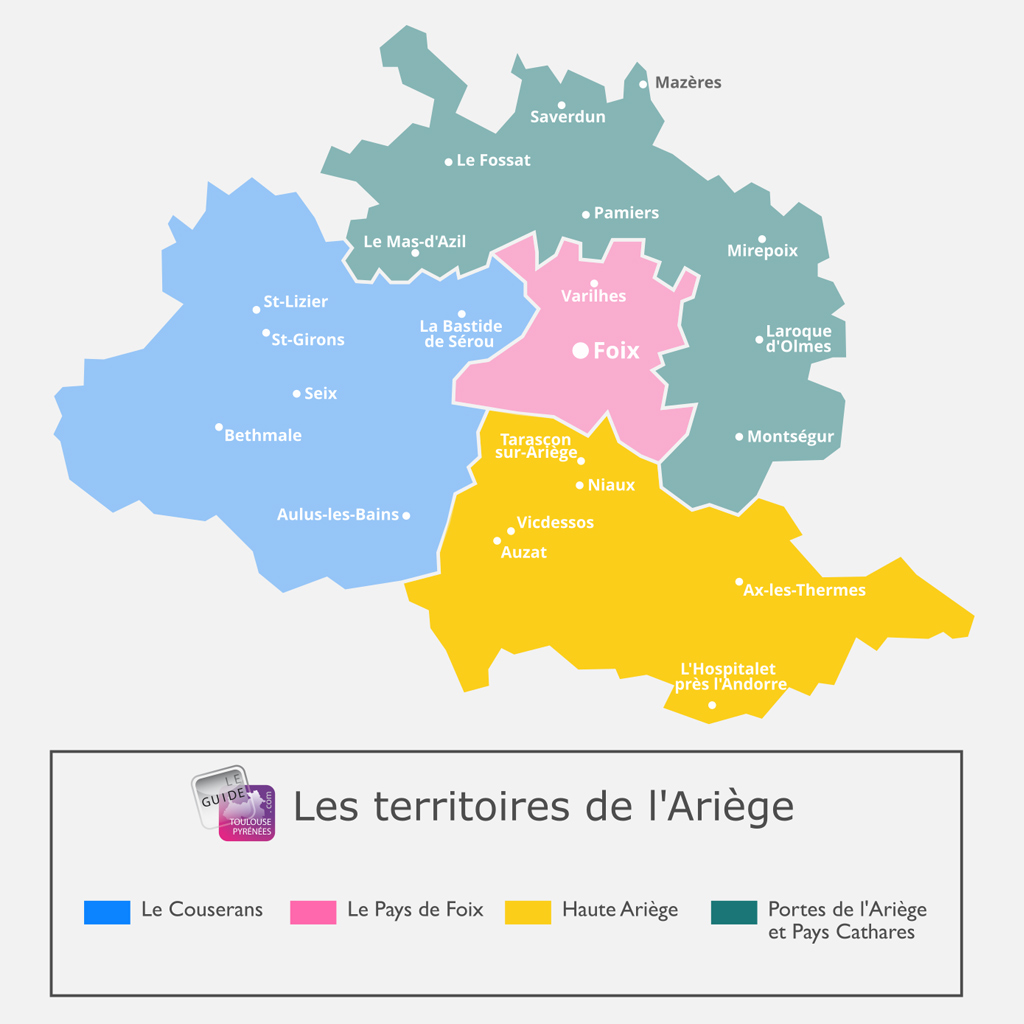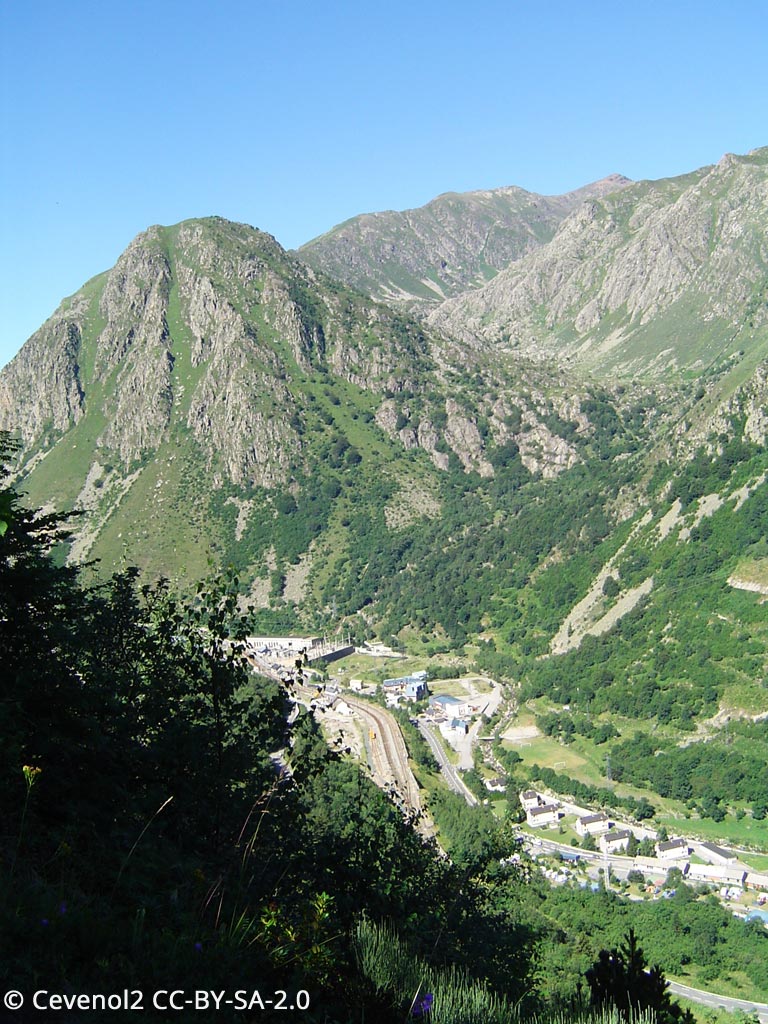- Home page
- Tourism
- Discover
- Visit Toulouse region and the French Pyrénées
- Ariège - La Haute Ariège
- Visit Toulouse region and the French Pyrénées
- Discover
- Tourism
Ariège - La Haute Ariège
Continuing to the south of the Pays de Foix, is the Haute Ariège. "Haute" (high) is used here as an adjective to qualify the relief and the mountain and high mountain landscapes, dotted with forests, of this territory. The focal pointis the Ariège River, which gives its name to department and carries with it the life, organised around its waters edge. Skiing, hiking, spas, geological and to pographical treasures...

An ideal place to go on holidays, if you like nature, cultural tourism and walking. It is a country where you can be curious, get into conversations with locals and discover the local cuisine. Have a great holiday!
Tarascon-sur-Ariège
Tarascon-sur-Ariège perches proudly on a rocky promontory, the lower town is at the confluence of the Ariège and Vicdessos Rivers. The mountain climate of this Middle Ages trade crossroads provides fabulous summer and winter landscapes. It is one of the most important cave painting centres of the department, with no less than four caves preserving the legacy of human habitation, the treasures of the region are underground!
- The Bédeilhac Cave, inhabited more than 15,000 yearsago and which has many paintings and engravings.
- The Grotte de la Vache (the Cow’s Cave), one of the most important prehistoric sites.
- The Niaux Cave, a Magdalenian decorated cave, an exceptional underground museum, for André Leroi-Gourhan, archaeologist and specialist of the prehistoric times, the only site « which competes with Lascaux and Altamira for the quality of its art, by the size of the art work and by the spirit that animates them… »
- The Lombrives Cave, dug out 200 millions years ago by the Ariège River, one of the most important which includes 39 km of galleries on 7 levels and can be visited on several circuits.
In the town, you can discover the rounded shape Castella Tower, built in 1775, which overlooks the river. The Sainte-Quitterie Church located in the town centre, was moved and rebuilt in 1773. The ruins of the fortifiedcompound are close to the Porte de Foix, where you can appreciate the16th and 17th centuries streets and the architecture of the town! The Notre Dame de Sabart Chapel (where 6 miracles happened) is next to La Daurade Church (where many concerts take place due to the acoustic properties of the building) and the 24 metre Saint Michel Tower.
Guide Toulouse Pyrénées’ Best Tips:
- Go to the Festival "Vents du Sud" (South Wind Festival) during summer!
- A few kilometres away from the village of Bannat, visit the Pyrenean Prehistoric Art Park.
- There are two markets in Tarascon, Wednesday morning and Saturday morning.
- For a relaxing time less than 6 km away, is Ussat-les-Bains and its spas.
- For train enthusiasts, go to Route d'Arignac, at the "Rail et Modélisme Ariégeois" with a postal carriage museum and a model electric train!
- At the fish farm of La Courbière, you can practice trout fishing in a lovely pond.
- A cool hiking trail nearby: Les Cascades de la Piche (La Piche waterfalls) in thePrayols Forest.
Niaux
The town of Niaux, close to Tarascon-sur-Ariège, is renowned for its forges and blacksmiths but also and especially for the Niaux Caves. The bestiary art is plentiful: buffalos, Alpine Ibexes, horses, deers, fishes and weasels (which are very rare!). These paintings are concentrated in the "Salon Noir" (Black Room), which is 700 metres from the entrance of the cave. In town you can also find the Niaux Pyrenean Museum, open every day of the year, created and managed by the Dejean Family.
Guide Toulouse Pyrénées’ Best Tips:
- Close to Niaux, is the Verdun Castle, a commune where a lovely project is taking place, the refurbishment of the Gudanes Castle by an Australian family. Owners of this enormous residence since in 2013, they are privately funding the renovation, with the help of some donations, of this castle with... 94 rooms ! If you are looking for a magical place to stay, contact them. The hosts are financing the refurbishment of this castle by offering bed and breakfast accommodation.
Vicdessos
A very small commune of 6km square, stretching from an altitude of 600 to 1500 metres! To see: the Notre Dame Church dating from the 11th century. If you like a bit of thrills, Vicdessos houses a fantastic Via Ferrata. A circuit along the rockywall which is accessible to all (from 6 years old). Superb view points ahead... The "Parc Moncalm Aventure" offers tree climbingand other thrilling activities! The weekly market is every Thursday morning on the Place du Gravier during summer and in the covered market Hall during winter.
Guide Toulouse Pyrénées’ best Tips:
- For the running enthusiasts, discover anew concept of signed trails: the Athlé-nature trails. The well-informed would say that they are just trails, yes but marked to meet the needs of runners of all levels! Many trails are available around Vicdessos and Auzat.
- The Chemin des Nobits (the newly weds) hike trail, starts from the Town Hall. You need around 2h30 to complete that trail which will bring you up to thevillage of Sentenac that sits just above Vicdessos.
- For warm and friendly holidays at a small budget, check the Centre d'Accueil de Vicdessos.
- Fancy some fresh air at altitude? Take off for your first paragliding flight with the Gypaetes Paragliding School!
Caves Campsite
Caves Campsite
Camping des Grottes welcomes you to Ariège, in the heart of the Ariège Pyrenees Regional Natural Park. Whether you ...
8,9 km - Alliat
Le Manoir d'Agnès
Le Manoir d'Agnès
Le Manoir d'Agnès, an elegant 3* hotel to discover at the foot of the Pyrenees Take the time to admire this ...
11,8 km - Tarascon-sur-Ariège
Hostellerie de la Poste
Hostellerie de la Poste
THE HOSTELLERIE DE LA POSTE IN TARASCON-SUR-ARIÈGE: A WARM PLACE FOR A GETAWAY IN THE HEART OF ARIÈGE Located in ...
12,4 km - Tarascon-sur-Ariège
Auzat
Auzat is a small lovely village, at the boundary of Andorra, around 800metres high. To the east of the commune, the Pique d'Estats peeks at 3,143 metres (10,312 feet) and where climbing is possible without difficulty. It is the highest point of the Montcalm Massif. The ruins of the Castle of Montréal are above the town, with an orientation table. Guided tours are available all year. The Maison des Patrimoines (The House of Heritage) offers an interpretation centre, conferences, organised walks and an exhibition room in a beautiful stone and wood building.
Guide Toulouse Pyrénées’ Best Tips:
- A horse ride in the region, is a fabulous idea for a change without getting tired! Go to the Auzat Equestrian Centre.
- If you prefer more hairy animals, the Lama Farm offers rides on the lamas! Careful not to upset them though, if not...
- Many mountain refugees are scattered allowing you stop overs for big hikes, go to the Tourist Office for more information.
- The Rucher de Saleix offers deliciousregional mountain honey and visiting the hives is possible with prior booking.
- In Auzat, the Etang de Soulcem rewards the hikers and drivers taking a long sinuous road. At 1,570 metres (5,151 feet) high, it is an artificial lake used for hydro electricity with displays of beautiful emerald colours.
Ax-les-Thermes
Ax-les-Thermes is mainly known for its thermal baths and its ski resort Ax 3 Domaines. The hot waters, with temperatures of up to 77°C, were mainly used to treat lepers in the Middle Ages. Its name, bassin des Ladres, testifies to this function and was built by the Count of Foix in the 13th century.
Numerous curists come each year to recharge their batteries, the thermal baths treating rheumatism, respiratory problems and sciatica. Three establishments are known, namely the Couloubret, the Teich and the Modèle. With nearly 70 springs, Ax-les-Thermes became one of the first important towns for thermal baths in France, as early as the 18th century.
Ax-les-Thermes is also appreciated for its leisure activities, its casino and theatre as well as its numerous parks.
The ski resort offers all its visitors magnificent views of the Pyrenean valleys. 36 slopes are open and will delight young and old alike.
L'Hospitalet-près-l'Andorre
 As indicated in its name, the town is located close the Principality of Andorra. You can reach the town by train from Toulouse (Portet-sur-Garonne more precisely) thanks to the Oriental Transpyrenean line that connects other towns of the department and also Spain. The Cirque Glacier of Sisca, including the Etang ofSisca, is a lovely hike: the hiking trail is long (6hoursreturn trip) but not difficult. L’Hospitalet is aresilient village due to its geographical position, which could be synonymous of economical or social difficulties. The local association "Que la Montagne est Rebelle" (What a rebellious Mountain), fights to save schools, employments and the services and amenities in this mountain village. The village does its best to attract new inhabitants and brings life to the village, which has so many assets to offer!
As indicated in its name, the town is located close the Principality of Andorra. You can reach the town by train from Toulouse (Portet-sur-Garonne more precisely) thanks to the Oriental Transpyrenean line that connects other towns of the department and also Spain. The Cirque Glacier of Sisca, including the Etang ofSisca, is a lovely hike: the hiking trail is long (6hoursreturn trip) but not difficult. L’Hospitalet is aresilient village due to its geographical position, which could be synonymous of economical or social difficulties. The local association "Que la Montagne est Rebelle" (What a rebellious Mountain), fights to save schools, employments and the services and amenities in this mountain village. The village does its best to attract new inhabitants and brings life to the village, which has so many assets to offer!
Guide Toulouse Pyrénées’ best tips:
- For the runners: In August. The Trophy of the Isardis a mountain raceof 15km with 1,000metres drop.
- Less than 30 kilometres away, us the beautiful ski resort of Grandvalira in Spain.
- Festi'moto is organised during summer, by the Moto Club of the town. Vroom vroom!
Les Appartements de Clelia
Les Appartements de Clelia
Clélia's Apartments: your vacation rental in Ax-les-Thermes Located on the heights of Ax-les-Thermes, in the heart ...
12,3 km - Ax-les-Thermes
Le Chalet d'en Castel
Le Chalet d'en Castel
LE CHALET D'EN CASTEL: A HAVEN OF PEACE IN AX-LES-THERMES Nestled in a green setting, just a 5-minute walk from the ...
12,3 km - Ax-les-Thermes
Camping d'Orlu
Camping d'Orlu
Come and recharge your batteries in the Orlu Valley! Our small mountain campsite classified 3 *** is located at an ...
14,6 km - Orlu






